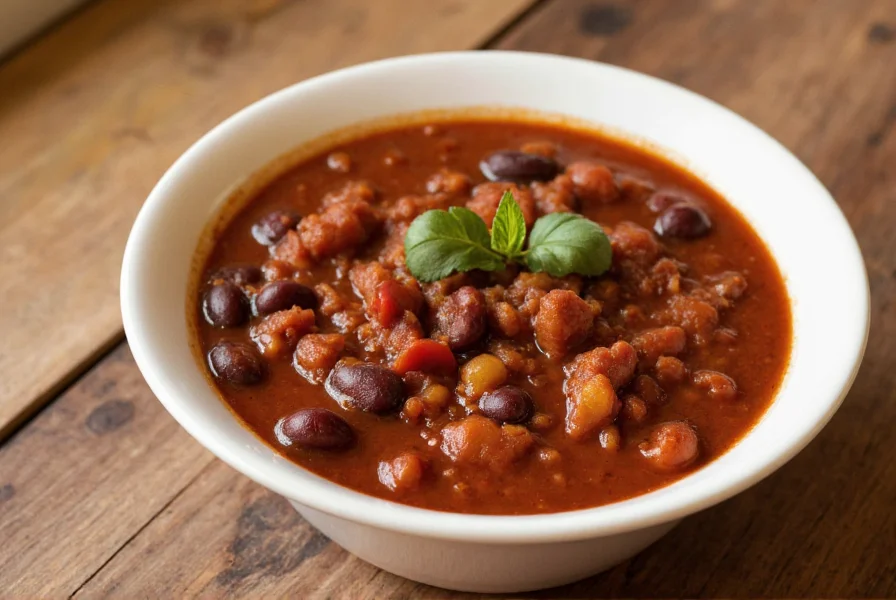The Culinary Science Behind Black Beans in Chili
Black beans transform classic chili with their unique properties. Unlike kidney or pinto beans, black beans maintain structural integrity during extended cooking, providing satisfying texture contrast. Their neutral earthiness absorbs surrounding flavors while contributing subtle cocoa-like notes that complement chili powder and cumin.
Food science explains why black beans excel in chili: their dense cell structure contains more soluble fiber than other beans, creating a natural thickening effect as they release starches during simmering. This eliminates the need for additional thickeners while creating a velvety texture. When preparing easy black bean chili for weeknight dinners, remember that canned beans require thorough rinsing to remove metallic aftertastes from the canning process.
Essential Ingredients Breakdown
| Ingredient | Function | Pro Tip |
|---|---|---|
| Black beans (2 cans) | Protein/fiber base | Rinse thoroughly; use one can mashed for thicker texture |
| Tomato paste (3 tbsp) | Flavor concentration | Cook 2 minutes before adding liquids to deepen flavor |
| Chipotle peppers (1-2) | Smoky heat dimension | Start with 1; add more after 30 minutes of simmering |
| Ground cumin (2 tsp) | Earthy foundation | Bloom in oil before adding other ingredients |
For vegetarian black bean chili with authentic flavor, substitute meat with 1 cup textured vegetable protein soaked in vegetable broth. The key to meatless versions is building umami through smoked paprika, soy sauce, and roasted mushrooms. Traditional meat-based versions benefit from browning 80/20 ground beef in batches to achieve proper fond development.

Perfecting Your Cooking Technique
The difference between good and exceptional chili with black beans and corn lies in technique. Begin by heating olive oil over medium-high heat until shimmering. Add onions and bell peppers, cooking until deeply caramelized (about 12 minutes). This Maillard reaction creates complex flavor compounds that form the flavor foundation.
When adding spices, toast them in the oil for 30 seconds until fragrant - this activates essential oils. For ground meat versions, brown in batches without overcrowding the pot. Overcrowding causes steaming rather than browning, resulting in gray, flavorless meat. After adding liquids, maintain a gentle simmer (small bubbles breaking surface every 5-10 seconds) rather than a rolling boil.
Avoiding Common Preparation Mistakes
Many home cooks make these critical errors when preparing healthy black bean chili recipes:
- Adding cold ingredients to hot pot - Temperature shock stops cooking processes; let refrigerated items reach room temperature first
- Over-stirring during simmering - Excessive agitation breaks down beans; stir only when necessary
- Skipping the resting period - Chili needs 15-20 minutes off-heat for flavors to integrate fully
- Using old spices - Ground spices lose potency after 6 months; test by rubbing between fingers (should release strong aroma)
Variations for Different Dietary Needs
Adapt this versatile dish for various preferences while maintaining authentic chili character:
- Vegan version: Use coconut aminos instead of Worcestershire sauce and add 2 tbsp nutritional yeast for umami depth
- Low-carb option: Reduce beans by half and add diced eggplant or zucchini that's been salted and roasted
- Spice-level control: Remove jalapeño seeds completely for mild chili; add a pinch of cayenne at the end for precise heat adjustment
For meal prep friendly black bean chili, portion into airtight containers with headspace for expansion. This dish freezes exceptionally well for up to 3 months. When reheating, add a splash of broth to restore optimal consistency.
Nutritional Benefits Worth Noting
Black beans elevate chili from comfort food to nutritional powerhouse. One cup provides 15g of protein and 15g of fiber - meeting nearly half your daily fiber needs. The soluble fiber in black beans helps regulate blood sugar by slowing carbohydrate absorption, making black bean chili for diabetes management an excellent choice.
Research shows regular bean consumption correlates with reduced risk of heart disease. The anthocyanins that give black beans their color act as potent antioxidants. When combined with tomatoes' lycopene, this creates a synergistic health benefit greater than either ingredient alone.
Frequently Asked Questions
Can I use dried black beans instead of canned in chili?
Yes, but you'll need to adjust preparation. Use 1 cup dried beans (about 6 oz) soaked overnight, then cook separately until tender before adding to chili. Dried beans require approximately 90 minutes of simmering and yield more consistent texture, but increase total preparation time by 2-3 hours.
Why does my black bean chili turn out watery?
Watery chili usually results from insufficient reduction or excess liquid. Fix this by: 1) Increasing tomato paste to 4 tablespoons, 2) Simmering uncovered for the last 20 minutes, 3) Mashing 1/3 of the beans to release natural thickeners, or 4) Creating a slurry with 1 tbsp cornstarch and 2 tbsp cold water added during final simmering.
How long does chili with black beans stay fresh in the refrigerator?
Properly stored in airtight containers, black bean chili maintains peak quality for 4-5 days in the refrigerator. The flavors actually improve during the first 48 hours as ingredients continue to meld. Always cool completely before refrigerating, and reheat only the portion you'll consume to maintain freshness of remaining portions.
What's the best way to freeze black bean chili?
Freeze chili in portion-sized containers with 1-inch headspace for expansion. For best results, use heavy-duty freezer bags laid flat to save space. Remove as much air as possible before sealing. Properly frozen chili maintains quality for 3 months. Thaw overnight in the refrigerator before reheating, or defrost in cold water for quicker preparation.











 浙公网安备
33010002000092号
浙公网安备
33010002000092号 浙B2-20120091-4
浙B2-20120091-4